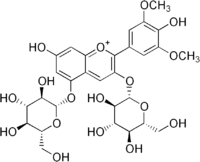- Malvin
-
For other uses, see Malvin (disambiguation).
Malvin  (2S,3R,4S,5S,6R)-2-[ [7-hydroxy-2-(4-hydroxy-3,5-dimethoxyphenyl)-5-[ [(2S,3R,4S,5S,6R)-3,4,5-trihydroxy-6-(hydroxymethyl)-2-tetrahydropyranyl]oxy]-3-chromenyliumyl]oxy]-6-(hydroxymethyl)tetrahydropyran-3,4,5-triol
(2S,3R,4S,5S,6R)-2-[ [7-hydroxy-2-(4-hydroxy-3,5-dimethoxyphenyl)-5-[ [(2S,3R,4S,5S,6R)-3,4,5-trihydroxy-6-(hydroxymethyl)-2-tetrahydropyranyl]oxy]-3-chromenyliumyl]oxy]-6-(hydroxymethyl)tetrahydropyran-3,4,5-triolIdentifiers CAS number 16727-30-3 PubChem 441765 Jmol-3D images Image 1 - COC1=CC(=CC(=C1O)OC)C2=C (C=C3C(=CC(=CC3=[O+]2)O)OC4 C(C(C(C(O4)CO)O)O)O)OC5C(C (C(C(O5)CO)O)O)O
Properties Molecular formula • C29H35O17+ (cation) • C29H35O17Cl (chloride)
Molar mass • 655.578 (cation) • 691.031 (chloride)
Exact mass 655.187425 Appearance reddish blue, odourless powder [1] Solubility in water nearly unsoluble [1]  (verify) (what is:
(verify) (what is:  /
/ ?)
?)
Except where noted otherwise, data are given for materials in their standard state (at 25 °C, 100 kPa)Infobox references Malvin is a naturally occurring chemical of the Anthocyanin family. It is a diglucoside of malvidin mainly found as a pigment in herbs like Malva (Malva sylvestris), Primula and Rhododendron.[2] It can be found in a variety of common foods, including but not limited to the following:[citation needed]
- Vegetables: radish, tomato, turnip, potato, pimento, black eyed pea, green pea, olive (green and black), onion, eggplant, cabbage, carrot, beet, avocado, corn
- Nuts: walnut, cashew
- Herbs/Spices: paprika, mustard seed, cinnamon
- Fruit: watermelon, rhubarb, strawberry, quince, peach, pear, plum, fig, grape (red and green), apple, apricot, banana, blackberry, blueberry, boysenberry, cherry, cranberry, black currants
- Fish: crabmeat
- Dairy: albumin (cow's milk), cheese, yoghurt, butter
- Sugar: sugar beet, honey
Malvin is not dangerous to ingest unless one develops an allergy toward it. An allergy to malvin may result in constipation, severe gas, vomiting or diarrhea when foods containing it are ingested in large amounts.[citation needed]
References
- ^ a b MSDS from CarlRoth (German)
- ^ J. A. Joule, K. Mills: Heterocyclic Chemistry., S. 173, Blackwell Publishing, 2000, ISBN 9780632054534
3-hydroxyanthocyanidins 5-Desoxy-peonidin | Aurantinidin | Cyanidin | 6-Hydroxycyanidin | Delphinidin | Fisetinidin | Guibourtinidin | Pelargonidin | Robinetinidin3-deoxyanthocyanidins Apigeninidin | Columnidin | Diosmetinidin | Gesneridin | Luteolinidin | TricetinidinO-methylated anthocyanidins Anthocyanins Antirrhinin | Chrysanthemin | Malvin | Myrtillin | Oenin | Primulin | Pulchellidin 3-glucoside | Pulchellidin 3-rhamnoside | TulipaninAcetylated glycosides Cyanidin-3-(di-p-coumarylglucoside)-5-glucoside (found in Dark opal basil) Violdelphin (found in Aconitum chinense)Misc. Metalloanthocyanins (Commelinin | Cyanosalvianin | Protocyanin | Protodelphin) | Pyranoanthocyanins | CopigmentationCategories:- Anthocyanins
- Phenol ethers
Wikimedia Foundation. 2010.
